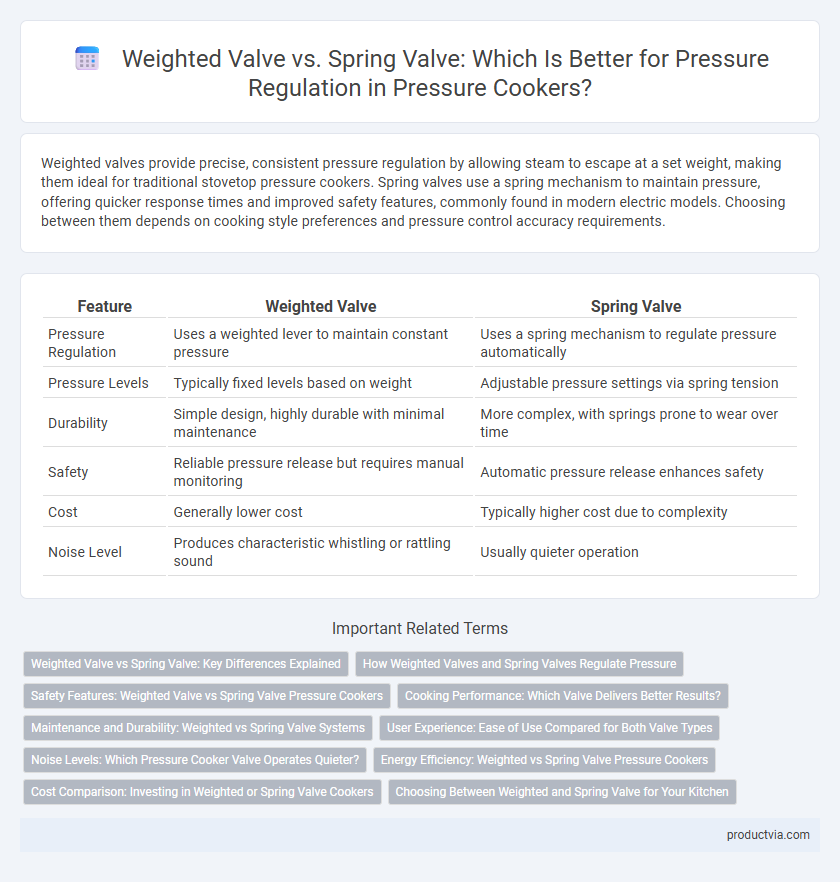Weighted valves provide precise, consistent pressure regulation by allowing steam to escape at a set weight, making them ideal for traditional stovetop pressure cookers. Spring valves use a spring mechanism to maintain pressure, offering quicker response times and improved safety features, commonly found in modern electric models. Choosing between them depends on cooking style preferences and pressure control accuracy requirements.
Table of Comparison
| Feature | Weighted Valve | Spring Valve |
|---|---|---|
| Pressure Regulation | Uses a weighted lever to maintain constant pressure | Uses a spring mechanism to regulate pressure automatically |
| Pressure Levels | Typically fixed levels based on weight | Adjustable pressure settings via spring tension |
| Durability | Simple design, highly durable with minimal maintenance | More complex, with springs prone to wear over time |
| Safety | Reliable pressure release but requires manual monitoring | Automatic pressure release enhances safety |
| Cost | Generally lower cost | Typically higher cost due to complexity |
| Noise Level | Produces characteristic whistling or rattling sound | Usually quieter operation |
Weighted Valve vs Spring Valve: Key Differences Explained
Weighted valves use a heavy disc or weight to maintain pressure, offering reliable and consistent pressure regulation that is simple to adjust by adding or removing weights. Spring valves rely on a calibrated spring to counterbalance the steam pressure, allowing for quicker pressure changes and typically providing easier maintenance and replacement. Weighted valves are preferred for traditional cookers due to their durability and straightforward mechanism, while spring valves are favored in modern pressure cookers for precision and faster response times.
How Weighted Valves and Spring Valves Regulate Pressure
Weighted valves regulate pressure by using a precise weight that balances against steam pressure, allowing excess pressure to lift the weight and release steam, maintaining consistent internal pressure. Spring valves utilize a calibrated spring that compresses under rising pressure, opening a valve to vent steam once the set pressure threshold is reached. Both mechanisms ensure safe pressure regulation by automatically controlling steam release based on pressure levels within the cooker.
Safety Features: Weighted Valve vs Spring Valve Pressure Cookers
Weighted valve pressure cookers use a heavy, calibrated weight that floats on steam, releasing excess pressure at a specific threshold to prevent dangerous build-up. Spring valve pressure cookers rely on a spring mechanism that compresses when pressure rises, triggering a release at a set point to maintain safe internal pressure levels. Both designs enhance safety by providing reliable pressure regulation, but weighted valves typically offer a more tactile indication of steam release, while spring valves provide precise control and faster response times.
Cooking Performance: Which Valve Delivers Better Results?
Weighted valves provide more consistent pressure regulation, resulting in precise cooking times and evenly cooked meals due to their ability to maintain steady pressure levels. Spring valves offer faster pressure adjustments but may cause slight fluctuations, potentially affecting delicate recipes that require stable heat. For optimal cooking performance, weighted valves are preferred for their reliability in delivering consistent results.
Maintenance and Durability: Weighted vs Spring Valve Systems
Weighted valve systems in pressure cookers offer simpler maintenance due to fewer moving parts and less frequent wear, enhancing long-term durability. Spring valve systems, while providing precise pressure regulation, require regular inspection and potential spring replacement to maintain optimal function. Overall, weighted valves tend to be more robust and easier to maintain, making them ideal for consistent, heavy-duty use.
User Experience: Ease of Use Compared for Both Valve Types
Weighted valves offer users straightforward operation by automatically maintaining pressure through a rotating weight, requiring minimal attention during cooking. Spring valves provide precise pressure control but may need manual adjustment or monitoring, which can be less intuitive for beginners. Overall, weighted valves enhance ease of use, making them more user-friendly for routine pressure cooking tasks.
Noise Levels: Which Pressure Cooker Valve Operates Quieter?
Weighted valves typically operate quieter than spring valves in pressure cookers, as they rely on gravity to regulate pressure instead of a mechanical spring mechanism that tends to produce more noise. The steady and controlled release of steam through weighted valves results in less clatter and rattling sounds during cooking. Spring valves may cause intermittent popping noises, making weighted valves a preferred choice for users seeking a quieter cooking experience.
Energy Efficiency: Weighted vs Spring Valve Pressure Cookers
Weighted valve pressure cookers maintain consistent pressure by using gravity to regulate steam release, resulting in steady energy consumption and optimal heat retention. Spring valve pressure cookers rely on a spring mechanism that can cause minor pressure fluctuations, potentially leading to increased energy use due to less stable cooking conditions. Weighted valves generally provide better energy efficiency by minimizing steam loss and maintaining uniform pressure throughout the cooking process.
Cost Comparison: Investing in Weighted or Spring Valve Cookers
Weighted valve pressure cookers generally cost more upfront due to their robust design and enhanced durability, making them a long-term investment for frequent cooking. Spring valve cookers are typically less expensive and easier to replace, appealing to budget-conscious buyers looking for affordable pressure regulation options. Evaluating long-term maintenance costs and cooking efficiency helps determine the best value between weighted and spring valve pressure cookers.
Choosing Between Weighted and Spring Valve for Your Kitchen
Weighted valves offer consistent pressure control through gravity, ideal for traditional stovetop pressure cookers and allowing precise cooking times based on pressure weights. Spring valves use a calibrated spring mechanism for pressure regulation, providing faster pressure release and safety features commonly found in modern electric pressure cookers. Choosing between weighted and spring valves hinges on cooking style preferences, with weighted valves preferred for slow, controlled cooking and spring valves favored for convenience and quick pressure adjustments in busy kitchens.
Weighted valve vs Spring valve for pressure regulation Infographic

 productvia.com
productvia.com